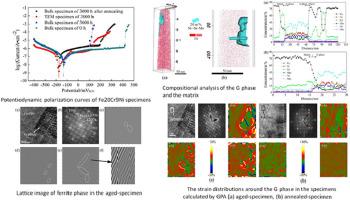当前位置:
X-MOL 学术
›
Acta Mater.
›
论文详情
Our official English website, www.x-mol.net, welcomes your
feedback! (Note: you will need to create a separate account there.)
Evaluation of pitting corrosion in duplex stainless steel Fe20Cr9Ni for nuclear power application
Acta Materialia ( IF 8.3 ) Pub Date : 2020-09-01 , DOI: 10.1016/j.actamat.2020.07.046 Yuefeng Chen , Bin Yang , Yangtao Zhou , Yuan Wu , Huihui Zhu
Acta Materialia ( IF 8.3 ) Pub Date : 2020-09-01 , DOI: 10.1016/j.actamat.2020.07.046 Yuefeng Chen , Bin Yang , Yangtao Zhou , Yuan Wu , Huihui Zhu

|
Abstract A spinodal decomposition is often carried out in the austenite-ferrite duplex stainless steel Fe20Cr9Ni during long-term service at a temperature in the range from 280 to 320°C, resulting in a decrease of pitting corrosion resistance. Fe-rich α phase rather than G-phase has been suggested as the major reason for the deterioration in pitting corrosion resistance of the thermally-aged steel. Here, we found that ∼76.8% of the decline in pitting resistance for the duplex stainless steel Fe20Cr9Ni was attributed to G-phase, and ∼23.2% to Fe-rich α phase after the spinodal decomposition. In this study, a suitable thermal aging treatment was introduced to obtain a larger size of the G-phase and to study the role of the phase in the corrosion process. Through immersing thermally-aged TEM specimen treated at 475°C for 3000 h in NaCl solution, the preferential position of corrosion pits formed in the ferrite was obtained. The composition changes and strain field distribution around the G-phase were analyzed by TEM-EDS, 3DAPT and GPA techniques. We further found that, although the concentration difference of Cr element between α and α’ phases was as high as 60 at.%, corrosion pits were initiated at the interface between the G-phase and the ferrite matrix rather than in the Fe-rich α phase, indicating that the Cr-depleted theory could not explain the aforesaid phenomenon. The strain energy at the interface between the G-phase and the ferrite matrix was found to be the largest. The atoms at the interface have higher energy than in the intracrystalline, and thus easily react with Cl− ions in the solution to form pits finally.
中文翻译:

核电用双相不锈钢Fe20Cr9Ni点腐蚀评价
摘要 奥氏体-铁素体双相不锈钢Fe20Cr9Ni在280~320℃的温度范围内长期使用时,常发生旋节线分解,导致耐点蚀性能下降。已提出富铁α相而不是G相是热时效钢耐点蚀性劣化的主要原因。在这里,我们发现双相不锈钢 Fe20Cr9Ni 抗点蚀性能下降的约 76.8% 归因于 G 相,约 23.2% 归因于旋节线分解后的富铁 α 相。在本研究中,引入合适的热时效处理以获得更大尺寸的 G 相并研究该相在腐蚀过程中的作用。通过将热老化 TEM 样品在 475°C 下浸入 NaCl 溶液中 3000 小时,获得了在铁素体中形成的腐蚀坑的优先位置。通过TEM-EDS、3DAPT和GPA技术分析了G相周围的成分变化和应变场分布。我们进一步发现,虽然 α 相和 α' 相之间 Cr 元素的浓度差高达 60 at.%,但腐蚀坑是在 G 相和铁素体基体之间的界面而不是富铁中开始的。 α 相,表明贫铬理论无法解释上述现象。发现 G 相和铁素体基体之间界面处的应变能最大。界面原子的能量高于晶内原子,因此容易与溶液中的Cl-离子反应最终形成凹坑。
更新日期:2020-09-01
中文翻译:

核电用双相不锈钢Fe20Cr9Ni点腐蚀评价
摘要 奥氏体-铁素体双相不锈钢Fe20Cr9Ni在280~320℃的温度范围内长期使用时,常发生旋节线分解,导致耐点蚀性能下降。已提出富铁α相而不是G相是热时效钢耐点蚀性劣化的主要原因。在这里,我们发现双相不锈钢 Fe20Cr9Ni 抗点蚀性能下降的约 76.8% 归因于 G 相,约 23.2% 归因于旋节线分解后的富铁 α 相。在本研究中,引入合适的热时效处理以获得更大尺寸的 G 相并研究该相在腐蚀过程中的作用。通过将热老化 TEM 样品在 475°C 下浸入 NaCl 溶液中 3000 小时,获得了在铁素体中形成的腐蚀坑的优先位置。通过TEM-EDS、3DAPT和GPA技术分析了G相周围的成分变化和应变场分布。我们进一步发现,虽然 α 相和 α' 相之间 Cr 元素的浓度差高达 60 at.%,但腐蚀坑是在 G 相和铁素体基体之间的界面而不是富铁中开始的。 α 相,表明贫铬理论无法解释上述现象。发现 G 相和铁素体基体之间界面处的应变能最大。界面原子的能量高于晶内原子,因此容易与溶液中的Cl-离子反应最终形成凹坑。











































 京公网安备 11010802027423号
京公网安备 11010802027423号